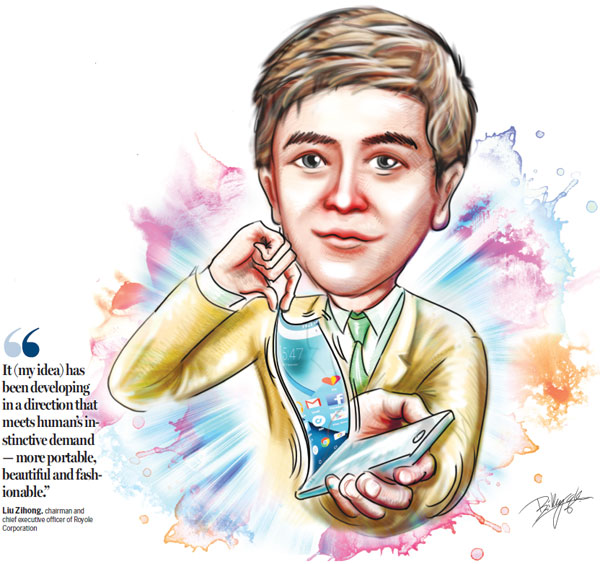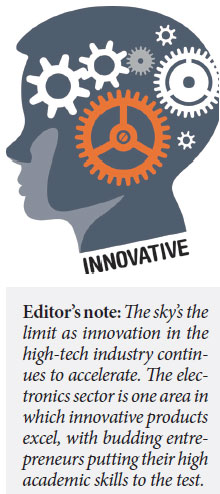Inventing a 'portable' future
Updated: 2015-03-12 07:56
By Zhou Mo in Shenzhen(HK Edition)
|
|||||||
In the next few years, you may find almost everyone walking on the streets holding a "pen" in their hands. Well, that "pen" is not for writing - it's probably what a future mobile phone would look like.
Such a scenario is likely to emerge with the creation of the world's thinnest full-color flexible display, which can be rolled up to a degree as thin as a pen core.
Compared with an ordinary display used in electronic devices, such as cell phones or tablets, normally with a thickness of 1 mm, the record-breaking product by Royole Corporation is only 0.01 mm thick and can be rolled up freely.

"The invention may bring a fundamental change to the shape of current electronic products," says Liu Zihong, chairman and chief executive officer of the technology enterprise.
Wearing a black-and-white striped shirt and a grey suit jacket, the 32-year-old Stanford University graduate with a doctoral degree looks calm and poised. He did not start his own entrepreneurial adventure immediately after graduation in 2009. Capital environment was bad at that time, as the world was in the midst of a severe financial crisis.
He worked for IBM in the US instead for two-and-a-half years, where he got to know how an international high-tech corporation operates, setting the stage for the future management of his own company.
Founded in 2012, Royole Corporation has offices in Shenzhen, Hong Kong and Silicon Valley in the US, with a total of more than 100 employees. Liu says research and development of the displays are conducted both in Shenzhen and Silicon Valley as the two places have their unique advantages.
"Shenzhen is the most developed city in terms of the industry chain of electronic devices. It also has a sound atmosphere for innovation as the city is open and inclusive. Moreover, it's adjacent to Hong Kong," he explains. "At Silicon Valley, you can find talents easily."
The company's Hong Kong branch, meanwhile, deals mainly with external cooperation matters.

The thought of "doing something that can last long" had sunk into Liu's mind since 2006 when he began his quest for a doctorate. But it did a long time of reflection before the vague notion finally brewed into the clear idea of making an innovative display screen.
"I came up with the idea of doing something relating to visual information input as it's something that has existed for thousands of years - from primitive carving to handwriting and then to current digital display - and it will always exist," Liu says.
"It has been developing in a direction that meets human's instinctive demand - more portable, beautiful and fashionable."
Liu's idea was recognized widely as a number of famed venture capital firms and angel investors rushed to invest in his venture. Among them were IDG Capital Partners, Shenzhen Capital Group and Green Pine Capital Partners. Within a year after its founding, Royole had raised more than 120 million yuan ($19.2 million). And, recently, the company completed its C-round financing.
In August last year, the special display screen officially made its debut. The product is now undergoing internal test and is expected to be largely used in mobile phones, tablets and wearable devices in the near future.
"The core advantage of our product is not limited to its thickness and flexibility," Liu says. "It's also a low-cost technology that can be mass produced."
Industry insiders, however, have adopted a conservative attitude towards the product's future. "The idea of Royole should be recognized as flexible display technology is one of the major directions of the whole industry," says Lyu Jianxin, deputy secretary-general of the Shenzhen Flat Panel Display Industry Association. "But there are several uncertainties."
"First, where will the huge amount of money come from to ensure its mass production? Second, will it have cost advantages after mass production? Third, will there be a large market demand for the product?"
The display technology which Royole adopts is called AMOLED (Active Matrix/Organic Light Emitting Diode) flexible, which is a branch of OLED technology. In October 2013, Samsung officially launched its Galaxy Round, whose display can also be curved. But the technology of Samsung's smartphone, AMOLED rigid plastic, is different from Royole's as it cannot be flexed repeatedly in use.
Compared with LCD, which has been widely used in TV panels, OLED display is thinner, lighter and has better color performances. Because of the advantages, the market of OLED displays is growing considerably.
According to the latest report by IDTechEx, a market research firm based in the UK, the market for plastic and flexible OLED displays is expected to expand from less than $2 billion this year to $16 billion by 2020. The new technology will experience rapid growth in various market segments over the next decade, with wearable electronics projecting over a 30-percent CAGR (compound average growth rate), followed by TV with 25 percent, the report says.
By comparison, growth in tablets and notebooks, as well as mobile phones, will be more modest, but still robust, approximately 12 percent and 8 percent CAGR, respectively, the report says.
Despite current achievements, Liu warns there are still challenges ahead.
"Different from the initial stage, in which we only needed to focus on developing our core technology, we now also have to deal with a number of other issues, such as industrialization of the product, marketing, external cooperation and so forth."
But he's determined and ambitious. On the wall in front of the company's entranceway hangs the company's slogan:"We Invent The Future".
"We're going to be the pioneer in the electronics industry with our revolutionary innovative technology," Liu says, brimming with confidence.
sally@chinadailyhk.com
(HK Edition 03/12/2015 page9)